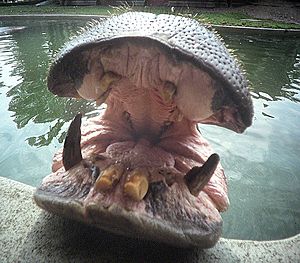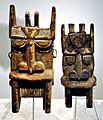Hippopotamus facts for kids
Quick facts for kids Hippopotamus |
|
|---|---|
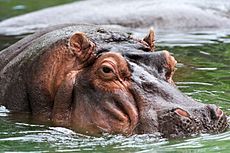 |
|
| A hippopotamus in the water at the Memphis Zoo | |
| Conservation status | |
| Scientific classification | |
| Kingdom: | |
| Class: | |
| Superorder: | |
| Order: | |
| Family: | |
| Genus: |
Hippopotamus
|
| Binomial name | |
| Hippopotamus amphibius |
|
 |
|
| Red: hippopotami used to live there; green: hippopotami still live in these areas | |
The hippopotamus (Hippopotamus amphibius), often called a hippo, is a huge mammal that lives in Africa. Its name comes from Ancient Greece and means "river horse." Hippos mostly eat plants. It is one of only two types of animals left in its family, called Hippopotamidae. The other is the pygmy hippopotamus.
The hippopotamus is the second largest land animal by size. It is the third largest land animal by weight. The elephant is the heaviest, and the white rhinoceros is the second heaviest. However, the rhino is a bit smaller than the hippo. The hippo is also the heaviest artiodactyl, which means it has hooves with an even number of toes.
Hippos are semi-aquatic. This means they spend a lot of time in rivers and lakes. Males lead groups of 5 to 30 females and young. During the day, they stay in the water or mud to keep cool. They even give birth to baby hippos in the water. At dusk, they come out to graze on grass. Hippos rest together in the water, but they like to graze by themselves.
A hippopotamus has a body shaped like a barrel. It has a very big mouth with large teeth. Its body is almost hairless, and it has short legs. Hippos are the third largest land mammals by weight. They weigh between 1.5 and 3 tonnes. White rhinoceroses weigh 1.5 to 3.5 tonnes. Elephants weigh 3 to 9 tonnes.
Even with short, fat legs, a hippo can run faster than a human. Some hippos can run at 30 km/h (19 mph) for short distances. The hippopotamus is one of the fiercest animals in the world. It is often called one of the most dangerous animals in Africa. There are about 125,000 to 150,000 hippos in Sub-Saharan Africa. Zambia has about 40,000 hippos. Tanzania has between 20,000 and 30,000. Hippos are threatened because they are losing their homes. They are also poached for their meat and ivory teeth.
Contents
What's in a Name?
The word "hippopotamus" comes from the ancient Greek word hippopotamos. This word is made of two parts: hippos, meaning "horse," and potamos, meaning "river." So, "hippopotamus" means "horse of the river."
When there is more than one hippopotamus, you can say hippopotami. You can also say 'hippopotamuses' or 'hippos'. Hippos are social animals. About 30 hippos live together in groups. A male hippopotamus is called a bull. A female hippopotamus is called a cow, and a baby hippo is called a calf. This animal is also known as the common hippopotamus or the Nile hippopotamus.
Hippo Features
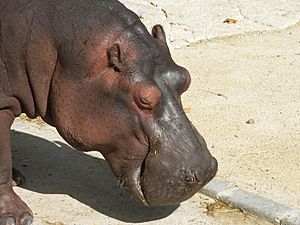

Hippopotami are among the largest mammals in the world. They are smaller than whales, elephants, and rhinoceroses. The Egyptian hippopotamus is smaller than other types. Hippos can live in the water or on land. They can even walk or run along the bottom of a river.
Because hippos are so large, it is hard to weigh them in the wild. Most adult male hippos weigh between 1,500 and 1,800 kg. Female hippos are smaller. They usually weigh between 1,300 and 1,500 kg. Older males can get even bigger. They can be at least 3,200 kg and sometimes even weigh 4,500 kg.
Male hippos seem to keep growing their whole lives. Female hippos, however, reach their heaviest weight around 25 years old. Hippos have big, heavy bodies and dark gray skin. They also have short legs. A hippo's main defense is its extremely strong mouth. They can grow to be 4.5 meters (15 feet) long and weigh 1,360 kilograms (3,000 pounds).
Hippo Life and Habits
Hippopotami are herbivores, meaning they eat plants. They live in groups. Even though they are semi-aquatic and have webbed feet, adult hippos are not very good swimmers. They also cannot float. They are rarely found in deep water. When they are, they move by leaping from the bottom.
Hippos usually stay in the mud and water during the day. They come out at night to eat grass or leaves. Though they are bulky animals, hippopotami can gallop at 30 km/h (19 mph) on land. They normally trot when moving.
Where Hippos Live
Many hippos lived in North Africa and Europe until about 30,000 years ago. They used to be common in Egypt's Nile region a long time ago. However, they are not there now. Pliny the Elder wrote that the best place to find hippos in Egypt was in the Saite nome. The animal could still be found there after the Arab Conquest in 639 AD.
Hippos are still found in the rivers and lakes of Uganda, Sudan, Somalia, Kenya, northern Democratic Republic of the Congo, and Ethiopia. They also live west through Ghana to Gambia. You can also find them in Southern Africa, including Botswana, Republic of South Africa, Zimbabwe, and Zambia. Some hippos also live in Tanzania and Mozambique. They like to live in places with water that is not too deep.
Hippos and Humans
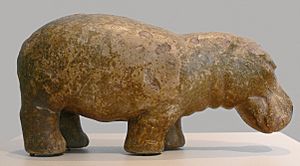
Why Hippos Can Be Dangerous
Hippos can be very aggressive towards humans. They often attack people in boats or on land without clear reason. This aggression happens because humans sometimes get too close to their babies. Hippopotami are very protective of their young. They often fear that humans are a big threat to their babies. They are widely considered to be one of the most dangerous large animals in Africa.
Hippos in History
The earliest sign that humans interacted with hippos comes from cut marks on hippo bones. These were found at Bouri Formation and are about 160,000 years old. Later, rock paintings and engravings showed hippos being hunted. These were found in the mountains of the central Sahara. They are from 4,000–5,000 years ago near Djanet.
Ancient Egyptians also knew a lot about hippos. They knew the hippo was a fierce, wild animal that lived in the Nile. In Egyptian mythology, Tawaret was a goddess of protection during pregnancy and childbirth. She had the head of a hippo. This was because ancient Egyptians saw how protective female hippopotami could be about their young.
Images for kids
-
Hippo's skull, showing the large canines and incisors used for fighting
-
Completely submerged hippo (San Diego Zoo)
-
Hippopotamus ("William"), Middle Kingdom of Egypt, c. 1961–1878 BC
-
Obaysch lounging at the London Zoo in 1852
See also
 In Spanish: Hipopótamo común para niños
In Spanish: Hipopótamo común para niños



